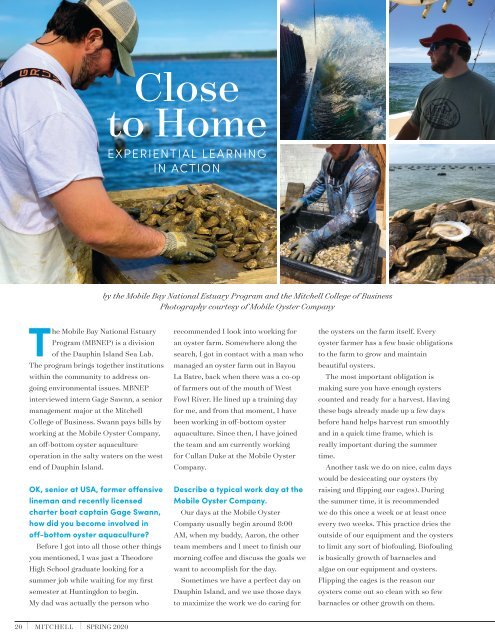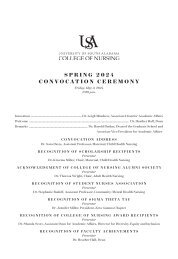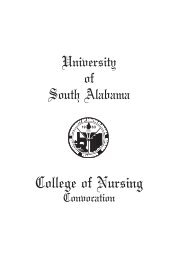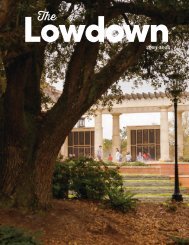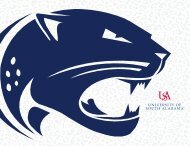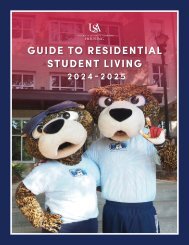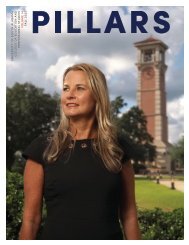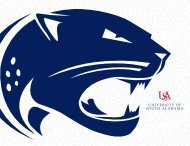Mitchell Magazine Spring 2020
Mitchell Magazine Spring 2020
Mitchell Magazine Spring 2020
Create successful ePaper yourself
Turn your PDF publications into a flip-book with our unique Google optimized e-Paper software.
Close<br />
to Home<br />
EXPERIENTIAL LEARNING<br />
IN ACTION<br />
by the Mobile Bay National Estuary Program and the <strong>Mitchell</strong> College of Business<br />
Photography courtesy of Mobile Oyster Company<br />
The Mobile Bay National Estuary<br />
Program (MBNEP) is a division<br />
of the Dauphin Island Sea Lab.<br />
The program brings together institutions<br />
within the community to address ongoing<br />
environmental issues. MBNEP<br />
interviewed intern Gage Sawnn, a senior<br />
management major at the <strong>Mitchell</strong><br />
College of Business. Swann pays bills by<br />
working at the Mobile Oyster Company,<br />
an of-bottom oyster aquaculture<br />
operation in the salty waters on the west<br />
end of Dauphin Island.<br />
OK, senior at USA, former ofensive<br />
lineman and recently licensed<br />
charter boat captain Gage Swann,<br />
how did you become involved in<br />
of-bottom oyster aquaculture?<br />
Before I got into all those other things<br />
you mentioned, I was just a Theodore<br />
High School graduate looking for a<br />
summer job while waiting for my frst<br />
semester at Huntingdon to begin.<br />
My dad was actually the person who<br />
recommended I look into working for<br />
an oyster farm. Somewhere along the<br />
search, I got in contact with a man who<br />
managed an oyster farm out in Bayou<br />
La Batre, back when there was a co-op<br />
of farmers out of the mouth of West<br />
Fowl River. He lined up a training day<br />
for me, and from that moment, I have<br />
been working in of-bottom oyster<br />
aquaculture. Since then, I have joined<br />
the team and am currently working<br />
for Cullan Duke at the Mobile Oyster<br />
Company.<br />
Describe a typical work day at the<br />
Mobile Oyster Company.<br />
Our days at the Mobile Oyster<br />
Company usually begin around 8:00<br />
AM, when my buddy, Aaron, the other<br />
team members and I meet to fnish our<br />
morning cofee and discuss the goals we<br />
want to accomplish for the day.<br />
Sometimes we have a perfect day on<br />
Dauphin Island, and we use those days<br />
to maximize the work we do caring for<br />
the oysters on the farm itself. Every<br />
oyster farmer has a few basic obligations<br />
to the farm to grow and maintain<br />
beautiful oysters.<br />
The most important obligation is<br />
making sure you have enough oysters<br />
counted and ready for a harvest. Having<br />
these bags already made up a few days<br />
before hand helps harvest run smoothly<br />
and in a quick time frame, which is<br />
really important during the summer<br />
time.<br />
Another task we do on nice, calm days<br />
would be desiccating our oysters (by<br />
raising and fipping our cages). During<br />
the summer time, it is recommended<br />
we do this once a week or at least once<br />
every two weeks. This practice dries the<br />
outside of our equipment and the oysters<br />
to limit any sort of biofouling. Biofouling<br />
is basically growth of barnacles and<br />
algae on our equipment and oysters.<br />
Flipping the cages is the reason our<br />
oysters come out so clean with so few<br />
barnacles or other growth on them.<br />
20 | MITCHELL | SPRING <strong>2020</strong>


